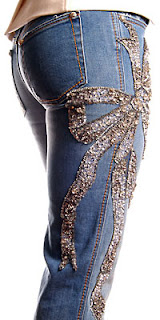Levi Strauss would be turning in his grave.
That's because the days of paying only $20 for a great pair of jeans are almost nonexistent. With details such as custom fitting and gem embellishments becoming more and more popular, denim makers are asking - and getting - prices never seen before.
But steeper prices - styles by popular brands such as Rock and Republic and 7 for All Mankind start around $150 a pair - aren't affecting consumer demand. In fact, premium denim jeans (those that cost $60 or more) claim only a small share of the jeans market, but have experienced the fastest sales growth over the past several years. In 2005, the number of premium pairs sold doubled over the previous year, and in the first eight months of this year, they've risen 33%, according to a report put out by NPD, a market research firm.
Despite their current rung on the fashion ladder, jeans had a more utilitarian beginning. During the California gold rush, a young immigrant named Levi Strauss landed in San Francisco hoping to start a dry goods store similar to his brother's in New York City. When he realized he needed work pants that could withstand any amount of wear and tear, the blue jean, made of a thick canvas-like material called denim, was born.
Today, jeans cost way more than the dollar they sold for in 1873. According to the Guinness Book of World Records, the most valuable jeans are a 155-year-old pair of Levis 501, bought by an anonymous bidder on eBay (nasdaq: EBAY) for $60,000 in 2005.
While vintage jeans may be in high demand and come with large price tags, newer pairs embellished with rivets and rhinestones are just as coveted. Department stores such as Neiman Marcus, Bergdorf Goodman and Saks Fifth Avenue have seen an increase in the sale of Roberto Cavalli's bejeweled premium denim (price tag: $1,185), a favorite of celebrities such as Jennifer Lopez and Beyonce Knowles, as well as $500 pairs made by Luxirie for LRG jeans and encrusted with Swarovski crystals.
Apparel companies such as Diesel and PRPS, known for selling jeans in the $150 to $200 price range, have introduced premium lines of hand-dyed "selvege" denim, made on looms that produce a tighter weave and heavier fabric. These $675 Diesel Denim Gallery jeans are sold in only three stores (two in New York, one in Japan) while PRPS sells their $475 jeans at Atrium in New York.
Factor in custom-made denim and the price skyrockets. Makers of the $4,000 APO jean use a choice of silver, gold or platinum rivets and replace the buttons with diamonds of the customer's choosing. Both the man-hours and luxe materials add to the price.
"They definitely are not for everyone," says Kingman Lam, chief executive of APO jeans.
 Designers also use hard-to-find denim when making a custom pair. Earnest Sewn fans flock to the designer's New York City headquarters to have a pair of jeans made to their specifications and with denim and detailing that may not have hit the market.
Designers also use hard-to-find denim when making a custom pair. Earnest Sewn fans flock to the designer's New York City headquarters to have a pair of jeans made to their specifications and with denim and detailing that may not have hit the market.  "In certain instances, people in the denim know will find out we are receiving reams of Japanese denim that weren't mass produced or haven't been available to the open market," says Scott Morrison, chief executive and designer. "People get excited and usually come in to get jeans made within days of us getting the shipment."
"In certain instances, people in the denim know will find out we are receiving reams of Japanese denim that weren't mass produced or haven't been available to the open market," says Scott Morrison, chief executive and designer. "People get excited and usually come in to get jeans made within days of us getting the shipment." The jeans, which cost between $800 and $1000, are typically made of hand-dyed raw denim without a hint of stretch. While they are at it, Earnest Sewn customers also weigh in on rivet size and color, with some opting for 24-carat gold plated buttons.
Jeans, like anything else in a person's wardrobe, have inevitably evolved to encompass any person's desire, from the very basic to the completely elaborate," says Morrison of the exploding popularity of high-end denim. "It's just a matter of what someone wants - and we try to provide that for them."



